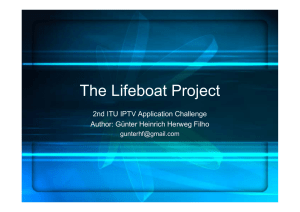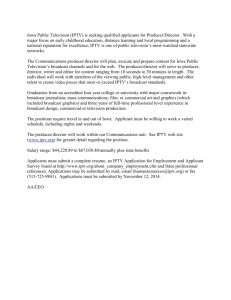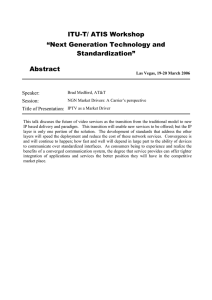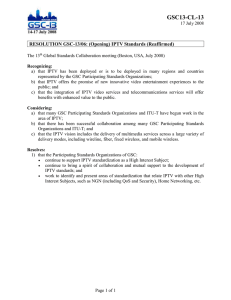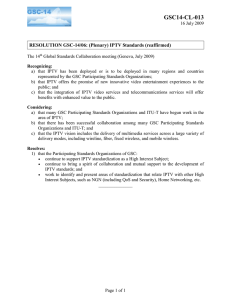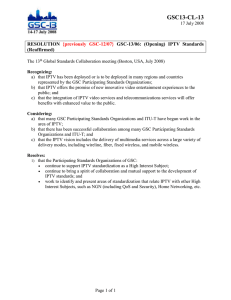IPTV: when broadcast finally sees the light? Marie-José Montpetit, Ph.D. Motorola
advertisement
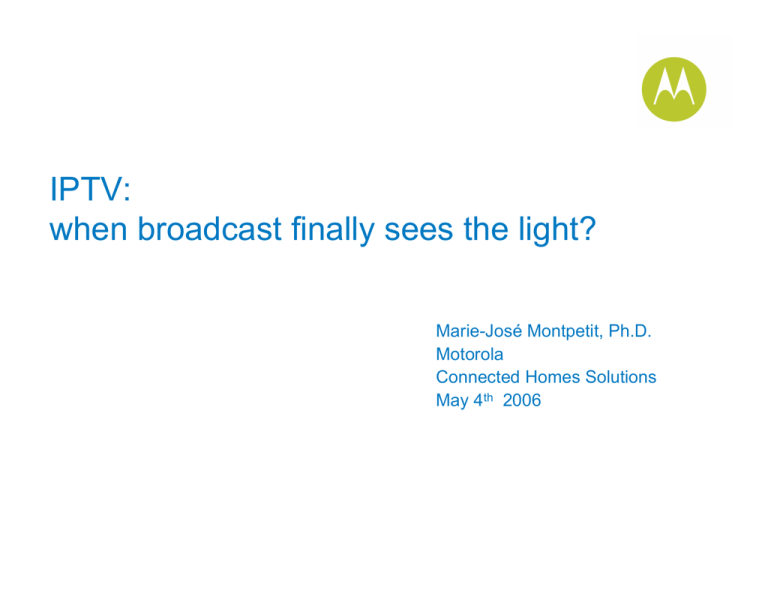
IPTV: when broadcast finally sees the light? Marie-José Montpetit, Ph.D. Motorola Connected Homes Solutions May 4th 2006 What is IPTV? • IP over TV? – Is done in the DVB world • TV over IP? – Video streaming has been here for a while (nRT and RT) • A new model or a replication of current offerings? – IPTV as Cable – The Internet as paradigm • Is IPTV more than broadcast – Quaduple play? Does that include mobile video? – Some new enhanced services? 2 Some interesting news items • Time Warner CTO on IPTV at NCTA – April 13 2006: – “IPTV? It’s a buzzword, like freaking ‘fiber.’ Who cares how it gets there? It’s a silly discussion. We can do all of it.” • Press Release – April 19 2006: – Telefonica and Lucent Technologies Reach Strategic Agreement to Support Telefonica's IPTV Service Rollouts Worldwide 3 Goals • Define IPTV • See what new converged networks developments bring to the IPTV debate • Review the IPTV puts as requirements to the converged networks 4 A bit of history… Before time, the big bang… • VCRs: • – Allows to view TV content when wanted – Quality an issue Early VOD – VCR “in the network” – Better quality – Pay to see TV content 6 Life starts (the broadcast branch) Premium Cable • Matrix model of cable offering (on screen guides) • Premium scrambled channels – Tier based billing • Video on demand and pay per view – Puts emphasis on choice and flexibility of schedule 1st step to (r)evolution (cable): separate timing/scheduling from high quality broadcast and add trick plays (pause, rewind, forward) 7 Life starts (the Internet branch) Streaming • Real Networks started streaming in 1998 – – – – Content in the network like VOD Content can be saved to disk like VCR Quality depends on connection speed Streaming of audio is now part of everyday life 1st step to (r)evolution (Internet): separate real time video content from the television screen and add PC functions to the viewing experience 8 The (r)evolution happens: the PVR • TiVO give PC like functionality and VOD quality/trick plays to everyday TV – Pause, fast forward and rewind live TV • Users gets used to seeing only what they want, when they want it • Broadcast content becomes a push-pull service not just push anymore 9 The (r)evolution continues – multiroom PVR and networked entertainment • Video is shared amongst TVs in the home (multiroom DVR) • IP Streaming becomes an in-house technology • The DVR is shared with personal devices – Backups? – Security? 10 IPTV v0.1 – Hybrids • Principle: leave broadcast on QAM – “Cable over fiber”: replicates the cable system – Add IP for VOD and enhanced services • Use the fiber network infrastructure for delivery • The STB "mixes" the 2 worlds But Internet content and broadcast content still are separate entities 11 IPTV 0.2 – xDSL: The big picture emerges • • • • • • 12 Move from IP data services to video Functions move to the network Rich media offerings over the IP network Converged Services STB connected to one another to create better services and leverage existing equipment (adaptor devices) Co-exist with other IP devices to offer rich content offerings IPTV v0.3 - Why just STBs? • Content is shared with PCs or their devices using IP technologies – No more TV "channels" but "streams“ – Integrated streaming services between STBs, streaming devices and PCs in and out of the house – VOD over IP via the PC (Akimbo for example) – Enhanced TV (games, video call in shows etc.) – Users start seeing "screens" and not underlying technology • Mobile device for TV – TV becomes "portable" (see Slingbox, TiVO to go, video blogging, video podcasting etc.) 13 IPTV v0.3 14 IPTV v0.4 – Who, where? • Only available where fiber is there already? – In the near future not only FTTH but FTTN or FTTC (ADSL2, ADSL2+, VDSL etc.) – Hybrid offerings: wireless (Wimax and 802.11n) and fiber – Cablelabs project on VoD over IP over DOCSIS – Interesting fact is there are a lot of early adopters in neighborhoods without fiber access • PON technologies bandwidth – About 30 Mbps per household (about 1.5 HD stream) – Enough for 1 HD and most current Internet content (as long as there is analog) – Stressful scenarios from “whole home DVR” solutions • STBs are not PCs (yet) – Pressures to keep costs low may impede deployment – Combine STBs and PCs to offer the requested services • Current deployments impaired by their own success – Servers need to scale to demand 15 IPTV v1.0 - The goal or the grail? • Full quadruple play plus enhanced services over the same medium – Opens avenues for integrated applications • Single network to operate – Cost of IP network gear vs. traditional TV headend equipment • Content moves freely between devices, between locations and independent of time – Regulatory issues? – Copyright and DRM issues – Studies have show users are ready to pay for location, time and device independent services 16 IPTV architectures Two models IPTV: video centric 18 IPTV: video centric • Should IPTV use what made digital broadcast TV great? – – – – Ownership of the ingress and egress point End to end control of content and quality On screen navigation and ease of use Heritage from cable and satellites • Network is a “pipe” – Bottlenecks at the edge • Internet for broadcasters – And client/server providers 19 IPTV: Internet Centric 20 IPTV: Internet Centric • Should IPTV use what made the Internet great? – – – – – Standard and horizontal network protocols Distributed functionality Multiple aggregation points Cheap end points Network of Networks • Network is a mesh – End to end QoS an issue • Video for the Internet providers – And distributed services/equipment providers 21 Network and Device Impacts IPTV and optical networks • Increase capacity – Switched models – WPONs – New approaches? • Increase stat mux – Push network intelligence beyond the PON in the OLT/ONT – At what price? • “Personal Broadband” – Requires moving potentially large amounts of data across network boundaries – Combine forces with wireless? • For mobility (“Tivo to go”) • In home distribution (direct modulation) • IMS model? 23 What new optical devices bring • What is always mentioned: – Lower costs devices enable deployment over larger areas – Higher density/rate devices allow to better use deployed assets • What is less often mentioned: – Reduced reliance on switched video solution • The current DSL approach • This is a design choice that has a lot of impact on network architecture, services and performance – Higher rate per users enable more services (HD videoconferencing) while reducing some operational expenditures (related to current admission of HD sessions for example) – Better use of in-home networks • What is the use of 200Mbps HPNA3 if the WAN connection has limits at 10s of Mbps – Content mobility • The content finds the user – Networked services that can compensate for gap in home devices (network-based PVRs, video transcoding, network buffers etc.) separate the content from the device while keeping the device price low • Delay & performance issues 24 IPTV and wireless networks • Increase capacity – – – – • Wimax 802.11n Direct RF to Fiber (direct modulation) At what price? IMS model – Distributed capabilities – Emerging as a control plane • “Personal Broadband” – Use the wireless infrastructure for convergence, remote control and redirection – Requires moving potentially large amounts of data across wireless bearers – Combine forces with optics? 25 What new wireless devices bring • What is always mentioned: – Lower costs devices enable deployment with a large number of users – Video capabilities for clips and short movies • What is less often mentioned: – Enables the movement of content independent of location and time – Customization of offerings and user centric networking – Content mobility • In the sense of redirection – Video services get out of the usual TV setup • TV for the iPOD generation 26 Unicast, multicast, broadcast? • Unicast perfect for “on demand” – – • Personalized content, advertisement, information Only when wanted But is this the only model? – 20 Mbps streams a strain • – Sharing? • • • Sports events, “catastrophes”, major events still attractive in a “broadcast” model ‘Hit' TV as a communal experience for example the morning after a TV "event" (American Idol last episode) Mix of models here to stay and a major requirement for any future deployments – – Assuming that the broadcast television model will remain important, and that is will be emulated over IP multicast, how much optimization for IP multicast is needed in the access network, and with how much fan-out? " In the universe of possible PON architectures, how do we place a value on having an inherent broadcast/multicast capability • • Little muxing possible with current VOD models Does it matter? How long will analog TV survive? – – Digital penetration at 75% or more Future of TV specific interfaces? 27 IP protocols? • Current dichotomy: – Streaming protocol (e.g. RTSP) • Proven performance • Standards – Signaling protocol (e.g. SIP) • Voice over IP centric • Need for more interworking? • If yes where? – Depends on the IPTV model 28 IPTV on what? • The “device previously known as the STB” – Is there another model? • The device currently known as the “handheld” – HD content? • The PCs and laptops – Backups? ? • All, others? – The home as a network – TV on the fridge door • Horizontal view: – Impact on software/middleware – Standards essential 29 So where are we now? Some more issues • IPTV inherits from, broadcast, wireless and Internet legacies – From the Internet: • Copyrights/DRM – How to broker different models? • Parental control over content • Billing – Flat rate vs. per service • QoS and congestion – For the wireless • Small end devices • Mobility • Voice centric – From the broadcast • Advertisement – Personal advertisement embedded in the streams? • Local rules – Sports blackout – Certain programming • Channel Surfing • EAS (Emergency Alert Service) • Conditional Access 31 Policy Concerns • Content – Digital Rights Management is key – Different models need “brokerage” – Network DVR (Maestro) failed because of content issues • Authentication and privacy – Am I really me? • FCC “A la carte services” – IPTV ideal for “pick and choose” programming – What is the business model? 32 In the future? • IPTV already? Was the future 6 months ago? – “Mitch Kapor Backs Open Source Software For Simplifying Internet TV Sept. 6, 2005” • Participatory Culture Foundation wants to make it easy for anyone to be an Internet-TV broadcaster • Builds on Podcasting success • Everyone is a broadcaster? – But some people are much better at doing it and people are ready to pay for it – Internet Streaming Media Alliance for promoting Open IPTV standards • Coming soon to a screen near you? Virtual presence and ambient networks – IPTV communities as a social phenomenon – Technology agnostic access; network aware video applications – Performance and performance knowledge are key 33 In the future? • The usual questions: – Is IPTV the “killer app”? – Need the network to be deployed but need the deployment to justify the network? 34
